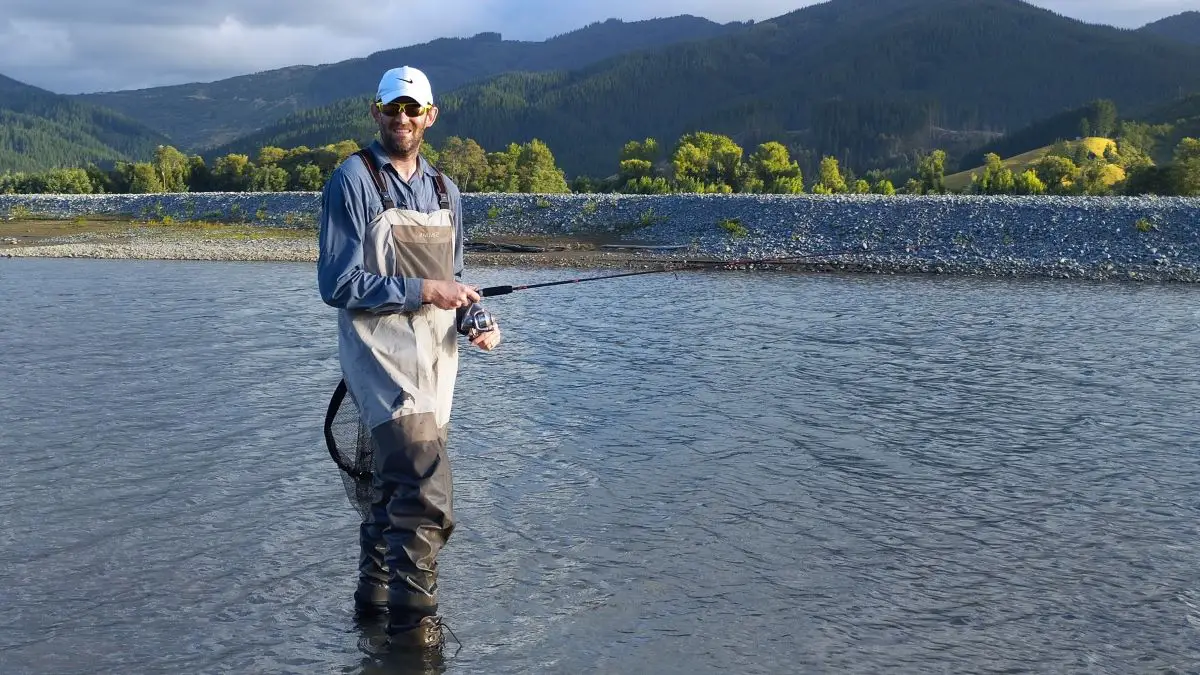Basically, it does not matter if you use monofilament or fluorocarbon as a leader. They all work and perform similarly.
So if you already own some line of around 4 or 6lb it will be fine to use for trout fishing.
To summarize the key differences quickly, Florourcabon is slightly more transparent while nylon/mono has a smaller diameter with stronger knot strength. Yes, this might be a controversial claim, but keep reading to hear my justification.
Transparency in water
Fluorocarbon is advertised as being next to invisible in the water. There is some truth to this claim. Its refraction rating, in other words how light bends through it is very comparable to water.
But, I will argue that the difference in transparency between floro and nylon is not enough to deter trout from striking, and there is certainly more to visibility than just refraction.
There is also reflection, that is how the light bounces off it. I have seen no evidence that fluorocarbon reflects light any better than monofilament.
Finally, and I personally consider this a big one. The shadow that the line casts across the water is what I suspect spooks most fish. With the sun above, both types of line can cast a shadow. but with the line diameter of only around 0.22mm the shadow it casts is rather thin. So again, it is not worth worrying about.
Time for some first hand proof. I have been fly fishing for years. We all know that mono sinks slower than fluoro. This makes it my first choice for tiny dry flies. When trout zone in on a minuscule size 20 Twilight Beauty, gently floating atop a crystal clear pool they completely ignore the nylon tippet.
In my experience mono tippets do not deter trout when fly fishing, so why would they deter trout when pulling a lure with one hundred times the bulk of a dry fly.
The only time, where the lower transparency of fluorocarbon might make a difference is when targeting very wary fish, in crystal clear still water combined with bright direct sunlight. But for 99% of trout I catch spinning, I am not convinced it makes a difference.
Difference in Abrasion Resistance
Many advertisement claims that fluorocarbon has been abrasion resistant. This is probably not true. I have seen enough head-to-head comparisons where fluorocarbon breaks first in abrasion tests compared with monofilaments.
This combines with the fact that when trout fishing abrasion resistance it not a large concern.
While brown trout are smart and fight dirty, freshwater fishing is simply not abrasive enough environment for the extra resistance to really matter.
Smooth scales cover trout bodies, not sandpaper skin like many marine species. Trout teeth are also not sharp enough to cut line.
In many years of trout fishing, a trout has never bitten me off, or broken me off due to abrasion.
The only times they have broken me off is when they wrap the line around underwater structure, and no amount of abrasion resistance is going to help.
Even when fishing 2lb nylon which seems slightly thicker than hair abrasion is not a big issue. Again, in my opinion this is a draw.
Knot Strength
Nylon has much stronger knot strength than fluorocarbon, knots are generally the weakest point in our fishing setup. So stronger knots mean fewer lost fish.
But if you take care, and tie good quality knots the difference is insignificant so another draw between the two types of line.
Nylon floats, floro sinks
Nylon sinks slower than fluorocarbon. This is true, and that is why many fly fishermen use nylon tippets for fishing dry flies but switch over to fluorocarbon when nymph fishing.
But, the difference in buoyancy between the two types of line is insignificant compared with the mass of the lures we typically fish. If you are fish flies behind a float, then this is one spin fishing situation where line type might make a difference.
Do I even need a leader when fishing with braid?
Some fishermen tie their lures directly to their braided mainline, this is not a good idea. While it is still possible to catch trout tying directly to braid, you are putting yourself at a disadvantage. Below I will outline the four main advantages using a leader offers.
- That is because braid is clearly more visible in the water so easier for the trout to see. It does not take much to convince a wary fish not to strike.
- Braid also lacks the abrasion resistance of monofilament lines. So every time that cunning old brown trout rubs against a rock or fallen branches the chance that braid will snap is greater than monofilament.
- Finally, braid the thin diameter of braid is much more likely to cut unprotected fingers, and even the skin of a trout. A thicker monofilament leader is kinder all round.
- Braid lacks the knot strength of monofilament, and knots are trickier to tie. Whenever I spin fish, I frequently change my lures. Tying knots in nylon is simply faster.
I should give some time to the counterarguments. The first is simplicity, by tying straight to the braid you simply need less gear. No need to carry a spool of monofilament with you, and there is one fewer knot that could fail.

